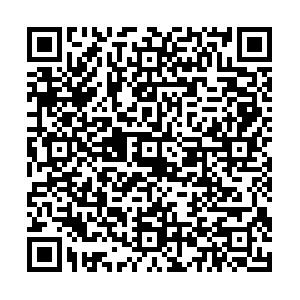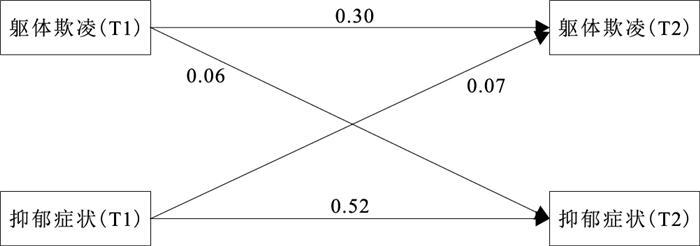A longitudinal cross-lagged study of the predictive effect of adolescent peer bullying on depressive symptoms
-
摘要:
目的 探讨青少年不同类型欺凌行为和抑郁症状之间的关系, 为进一步预防青少年同伴欺凌提供科学依据。 方法 基于2019年9月(T1)和2020年9月(T2)对安徽省淮北市1 687名青少年队列随访数据, 采用交叉滞后回归方法探讨不同类型同伴欺凌与抑郁症状的相互关系。 结果 T2时遭受欺凌行为(躯体欺凌、言语欺凌、关系欺凌、网络欺凌)和抑郁症状得分均低于T1时, 差异均有统计学意义(t值分别为13.60, 8.61, 7.24, 3.76, 8.29, P值均 < 0.01)。两个时期青少年的欺凌行为与抑郁症状之间均呈正相关(P值均 < 0.01);交叉滞后回归分析显示, T1时期的遭受躯体、言语、关系和网络欺凌均能正向预测T2时期的抑郁症状(β值分别为0.06, 0.04, 0.12, 0.05), T1时期的抑郁症状也能正向预测T2时期遭受躯体、言语、关系和网络欺凌(β值分别为0.07, 0.10, 0.13, 0.10)(P值均 < 0.05)。 结论 青少年同伴欺凌与抑郁症状之间相互影响, 存在一定的双向关联。 Abstract:Objective To explore the relationship between different types of bullying behavior and depressive symptoms among adolescents, and to provide scientific basis for further prevention of peer bullying. Methods Based on the follow-up data of 1 687 adolescents from Huaibei City, Anhui Province in September 2019 (T1) and September 2020 (T2), the autoregressive cross-lagged analysis was employed to explore the relationship between different types of peer bullying and depressive symptoms. Results The scores of bullying behaviors (physical bullying, verbal bullying, relational bullying and cyber bullying) and depressive symptoms at T2 were lower than those at T1, and the differences were statistically significant (t=13.60, 8.61, 7.24, 3.76, 8.29, P < 0.01). There was a positive correlation between bullying behavior and depressive symptoms (P < 0.01). The results from cross-lagged regression analysis showed that physical, verbal, relational and cyber bullying at T1 could positively predict depressive symptoms at T2 (β=0.06, 0.04, 0.12, 0.05), and physical, verbal, relational and cyber bullying at T1 could positively predict depressive symptoms at T2 (β=0.07, 0.10, 0.13, 0.10) (P < 0.05). Conclusion There were bidirectional associations between adolescent peer bullying and depressive symptoms. -
Key words:
- Violence /
- Depression /
- Mental health /
- Regression analysis /
- Adolescent
1) 利益冲突声明 所有作者声明无利益冲突。 -
表 1 不同性别学生在基线和随访时不同类型欺凌行为与抑郁症状得分比较(x±s)
Table 1. Comparison of scores of different types of bullying behavior and depressive symptoms between students of different genders at baseline and follow-up(x±s)
性别 人数 基线 随访 躯体欺凌 言语欺凌 关系欺凌 网络欺凌 抑郁症状 躯体欺凌 言语欺凌 关系欺凌 网络欺凌 抑郁症状 男 1 019 2.25±0.72 2.81±1.07 2.60±1.11 2.13±0.53 20.06±9.80 2.12±0.52 2.45±0.86 2.32±0.84 2.08±0.41 17.36±11.03 女 668 2.28±0.74 2.89±1.14 2.63±1.07 2.14±0.58 22.36±11.16 2.15±0.55 2.12±0.52 2.44±0.99 2.09±0.43 20.97±12.77 合计 1 687 2.26±0.73 2.84±1.10 2.61±1.09 2.13±0.55 20.97±10.42 2.13±0.23 2.46±0.86 2.37±0.90 2.08±0.42 18.79±11.88 t值 -0.83 -1.52 -0.44 -0.59 -4.35 -0.97 -0.86 -2.71 -0.33 -5.99 P值 0.18 0.14 0.23 0.44 <0.01 0.20 0.23 0.01 0.64 <0.01 表 2 不同类型欺凌行为与抑郁症状的相关矩阵(r值,n=1 687)
Table 2. Correlation matrices of different types of bullying and depressive symptoms(r,n=1 687)
变量 躯体欺凌T1 躯体凌凌T2 言语欺凌T1 言语欺凌T2 关系欺凌T1 关系欺凌T2 网络欺凌T1 网络欺凌T2 抑郁症状T1 躯体欺凌T2 0.31 言语欺凌T1 0.40 0.19 言语欺凌T2 0.30 0.45 0.35 关系欺凌T1 0.55 0.22 0.53 0.30 关系欺凌T2 0.28 0.49 0.24 0.53 0.33 网络欺凌T1 0.39 0.18 0.32 0.19 0.38 0.18 网络欺凌T2 0.22 0.41 0.18 0.39 0.21 0.41 0.31 抑郁症状T1 0.25 0.14 0.35 0.21 0.37 0.23 0.20 0.16 抑郁症状T2 0.19 0.24 0.22 0.33 0.31 0.42 0.15 0.22 0.53 注:T1代表基线,T2代表随访。P值均<0.01。 -
[1] OLWEUS D. Bullying at school. Basic facts and an effective intervention programme[J]. Promot Educ, 1994, 1(4): 27-31, 48. doi: 10.1177/102538239400100414 [2] SU P Y, WANG G F, HE H, et al. Is involvement in school bullying associated with increased risk of murderous ideation and behaviours among adolescent students in China?[J]. BMC Psychiatry, 2019, 19(1): 121. doi: 10.1186/s12888-019-2108-5 [3] CDC. Preventing bullying[EB/OL]. (2021-09-10)[2021-09-10]. https://www.cdc.gov/violenceprevention/youthviolence/bullyingresearch/fastfact.html. [4] HUANG Y, WANG Y, WANG H, et al. Prevalence of mental disorders in China: a cross-sectional epidemiological study[J]. Lancet Psychiatry, 2019, 6(3): 211-224. [5] JADAMBAA A, THOMAS H J, SCOTT J G, et al. The contribution of bullying victimisation to the burden of anxiety and depressive disorders in Australia[J]. Epidemiol Psychiatr Sci, 2019, 29: e54. [6] BRUNSTEIN K A, BARZILAY S, APTER A, et al. Bi-directional longitudinal associations between different types of bullying victimization, suicide ideation/attempts, and depression among a large sample of European adolescents[J]. J Child Psychol Psychiatry, 2019, 60(2): 209-215. doi: 10.1111/jcpp.12951 [7] WANG G F, JIANG L, WANG L H, et al. Examining childhood maltreatment and school bullying among adolescents: a cross-sectional study from Anhui Province in China[J]. J Interp Viol, 2016, 34(5): 980-999. [8] FENDRICH M, WEISSMAN M M, WARNER V. Screening for depressive disorder in children and adolescents: validating the Center for Epidemiologic Studies Depression Scale for Children[J]. Am J Epidemiol, 1990, 131(3): 538-551. doi: 10.1093/oxfordjournals.aje.a115529 [9] YUAN G, LIU Z. Longitudinal cross-lagged analyses between cyberbullying perpetration, mindfulness and depression among Chinese high school students[J]. J Health Psychol, 2021, 26(11): 1872-1881. doi: 10.1177/1359105319890395 [10] NOVICK A M, FORSTER G L, HASSELL J E, et al. Increased dopamine transporter function as a mechanism for dopamine hypoactivity in the adult infralimbic medial prefrontal cortex following adolescent social stress[J]. Neuropharmacology, 2015, 97: 194-200. doi: 10.1016/j.neuropharm.2015.05.032 [11] FINAN P H, SMITH M T. The comorbidity of insomnia, chronic pain, and depression: dopamine as a putative mechanism[J]. Sleep Med Rev, 2013, 17(3): 173-183. doi: 10.1016/j.smrv.2012.03.003 [12] VON KORFF M V, SIMON G. The relationship between pain and depression[J]. Br J Psychiatry, 1996, 168: 101-108. doi: 10.1192/S0007125000298474 [13] CHO M K, BAEK H C, SHIN G. Gender-based experiences of verbal bullying in adolescents: application of Giorgi's method[J]. J Psychosoc Nurs Ment Health Serv, 2019, 57(6): 45-51. doi: 10.3928/02793695-20190124-01 [14] OQUENDO M A, GALFALVY H, RUSSO S, et al. Prospective study of clinical predictors of suicidal acts after a major depressive episode in patients with major depressive disorder or bipolar disorder[J]. Am J Psychiatry, 2004, 161(8): 1433-1441. doi: 10.1176/appi.ajp.161.8.1433 [15] BAUMAN S, TOOMEY R B, WALKER J L. Associations among bullying, cyberbullying, and suicide in high school students[J]. J Adolesc, 2013, 36(2): 341-350. doi: 10.1016/j.adolescence.2012.12.001 [16] HELMS S W, GALLAGHER M, CALHOUN C D, et al. Intrinsic religiosity buffers the longitudinal effects of peer victimization on adolescent depressive symptoms[J]. J Clin Child Adolesc Psychol, 2015, 44(3): 471-479. doi: 10.1080/15374416.2013.865195 [17] WEBER S, PUSKAR K R, REN D. Relationships between depressive symptoms and perceived social support, self-esteem, & optimism in a sample of rural adolescents[J]. Issues Ment Health Nurs, 2010, 31(9): 584-588. doi: 10.3109/01612841003775061 [18] STICCA F, PERREN S. Is cyberbullying worse than traditional bullying? Examining the differential roles of medium, publicity, and anonymity for the perceived severity of bullying[J]. J Youth Adolesc, 2013, 42(5): 739-750. [19] HELLFELDT K, LOPEZ-ROMERO L, ANDERSHED H. Cyberbullying and psychological well-being in young adolescence: the potential protective mediation effects of social support from family, friends, and teachers[J]. Int J Environ Res Public Health, 2019, 17(1): 45. doi: 10.3390/ijerph17010045 [20] PARKINSON C M, MCWHINNIE C M, ABELA J R Z. Cognitive vulnerability to depression in children and adolescents: the role of self-critical and personal standards perfectionism[J]. J Affect Disord, 2008, 107(1): s57 [21] DAVIES P T, MARTIN M J, STURGE-APPLE M L, et al. The distinctive sequelae of children's coping with interparental conflict: testing the reformulated emotional security theory[J]. Dev Psychol, 2016, 52(10): 1646-1665. doi: 10.1037/dev0000170 [22] CONG Z, AN L. Developing of security questionnaire and its reliability and validity[J]. Chin Ment Health J, 2004, 18: 97-99. [23] MUSA A K J, MESHAK B, SAGIR J I. Adolescents' perception of the psychological security of school environment, emotional development and academic performance in secondary schools in gombe metropolis[J]. J Educ Train Stud, 2016, 4: 144-153. [24] TRAN C V, COLE D A, WEISS B. Testing reciprocal longitudinal relations between peer victimization and depressive symptoms in young adolescents[J]. J Clin Child Adolesc Psychol, 2012, 41(3): 353-360. -







 下载:
下载:




